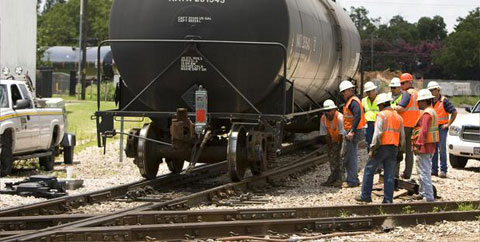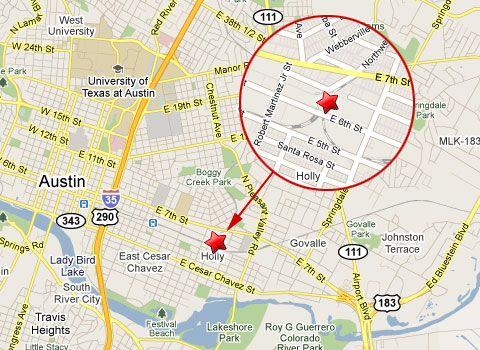AUSTIN, TX – Two freight train derailments occur in Austin, Texas within a week of each other. The most recent derailment occurred on Wednesday, July 7, 2010 and the one just prior to that occurred on the Sunday preceding.

Railroad workers inspect tracks at the scene of a Capital Metro freight locomotive derailment in Austin, TX. Photo credit: American Statesman
Austin is located in Travis County, Texas in the central part of the state about 161 miles northwest of Houston, about 199 miles southwest of Dallas, about 499 miles southeast of Amarillo and about 80 miles northeast of San Antonio.
The recent freight train derailments both occurred in the same location – a section of track where three tracks converge. Both derailments may have been related to a new piece of equipment that was intended to keep trains on the track.

Location of recent freight train derailments in downtown Austin, TX
There is a new piece of equipment called a “point protector,” installed about a week ago by Capital Metro rail at a location called the “wye”. Officials are now looking into whether or not it may have contributed to two recent freight train derailments.
According to Capital Metro officials, the derailment on Wednesday forced the cancellation of all morning MetroRail trains and blocked Seventh Street traffic for several hours.
In a recent article at the American Statesman website, Doug Allen, Capital Metro’s interim chief executive officer, was qoted as saying, “The wye is a challenging piece of track and one we’ve had our eye on already.”
Allen emphasized that incidents such as the recent derailments were what the equipment was designed to prevent. He stated that was the reason why the piece of equipment was there and that they were going to look into it and determine the best course of action.
Allen said that although the agency is still studying the issue, it could include straightening the track just north of the wye.
Officials said that another Capital Metro freight locomotive derailed at the same spot on Sunday, July 4, 2010, but MetroRail was unaffected by that incident due to the fact that there was no service on weekends.
In both derailments, no injuries were reported.
There is a 32-mile section of track between Leander and downtown Austin where the MetroRail passenger service runs that was affected by Wednesday’s derailment. After the freight locomotives and rail cars had been cleared from the derailment site, the MetroRail trains resumed their regular runs for Wednesday afternoon and evening.
Below is a Google street view of the corner of Northwestern Ave. and Hidalgo Street looking southward towards the section of track where the derailment occurred. You can clearly see the convergence of the tracks in the distance and the exact spot where the derailment occurred. Double-click the mouse on the tracks in the image to zoom in and get a clear view of the tracks.
Federal Railroad Administration (FRA) rules require that freight equipment be cleared out of the railway corridor before any passenger trains would be allowed to enter that area.
MetroRail trains were expected to run on schedule after the tracks were cleared.
MetroRail makes 19 runs per day in the corridor from Leander to Austin with an average of 779 boardings per weekday during May of this year. About 400 commuters had to have been affected on Wednesday morning based on this average and the cancelled runs.
Wednesday’s derailment was not considered to be serious because no freight cars or locomotives were seriously damaged or overturned. It was referred to as a “walk off” – where a train wheel leaves the track at slow speed but the train does not overturn.
The mishap occurred between 2:00 and 3:00 in the morning at the wye south of Seventh Street. The 67-car freight train, operating on track owned by Capital Metro, was travelling southbound at the time. The train’s contractor at the time was Watco Companies Inc.
In the derailment, the locomotive was moving at about 5 mph when it hopped the track.
Published by FELA lawyer Gordon, Elias & Seely, LLP
